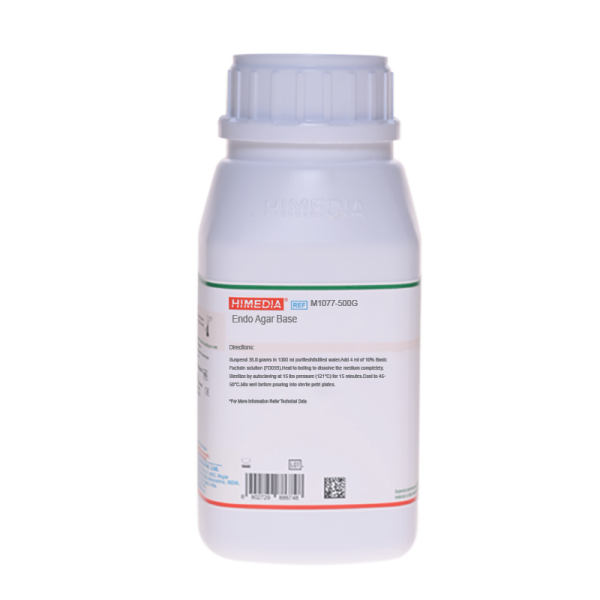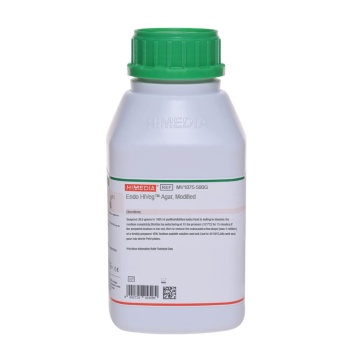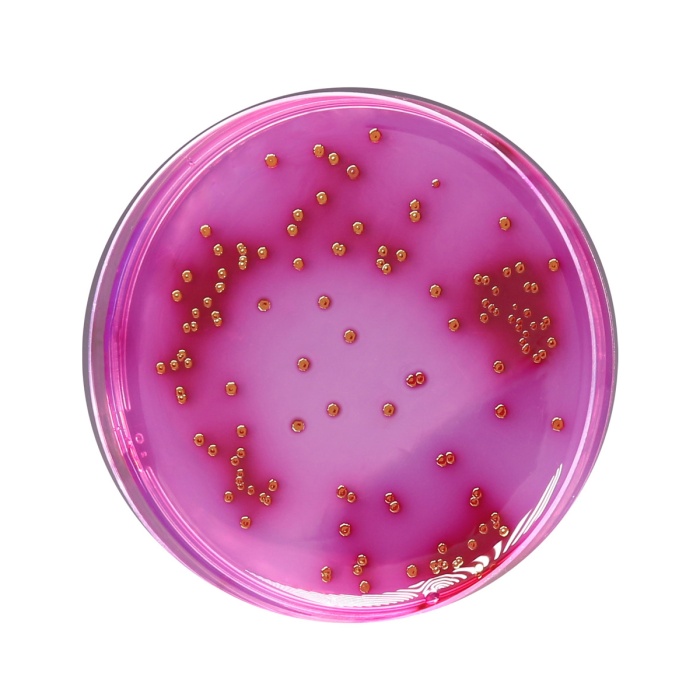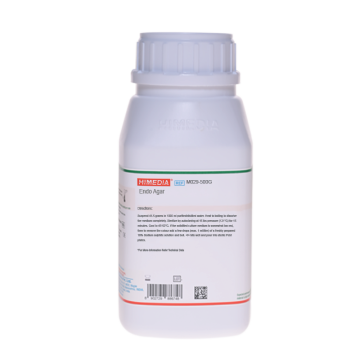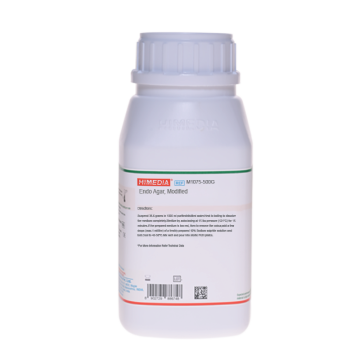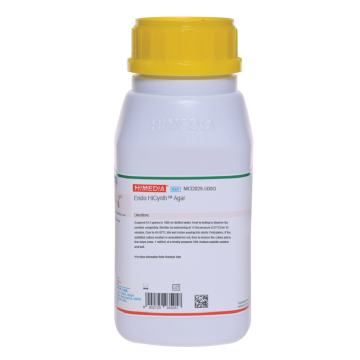 Your enquiry has been submitted
Your enquiry has been submitted
Endo Agar Base
Intended Use:
Recommended for preparing Endo Agar to confirm presumptive test for lactose fermenting coliforms.
Composition**
| Ingredients | g/L |
|---|---|
| Peptone | 10.000 |
| Lactose | 10.000 |
| Dipotassium hydrogen phosphate | 3.500 |
| Sodium sulphite | 2.500 |
| Agar | 12.000 |
Final pH (at 25°C): 7.5±0.2
**Formula adjusted, standardized to suit performance parameters
Directions
Suspend 38 grams in 1000 ml purified / distilled water. Add 4 ml of 10% Basic Fuchsin (FD059). Heat to boiling to dissolve the medium completely. Sterilize by autoclaving at 15 lbs pressure (121°C) for 15 minutes. Cool to 45-50°C. Mix well before pouring into sterile Petri plates.
Principle And Interpretation
Endo had first developed a culture medium for differentiation of lactose fermenters and lactose non-fermenters while inhibiting gram-positive bacteria (1). Inhibition of the later was achieved without the use of bile salts as was traditionally used. Endo was successful in inhibiting gram-positive bacteria on his medium by the incorporation of sodium sulphite and basic fuchsin. The resulting Endo Agar, also known as Fuchsin Sulphite and Infusion Agar, was used to isolate the typhoid bacilli. Many modifications of this media have been done over the years. Endo Agar is recommended by APHA as an important medium in the microbiological examination of water and wastewater, dairy products and foods (2,3,4). Endo Agar is used to confirm the detection and enumeration of coliform bacteria following presumptive test of drinking water. It is also used for the detection and isolation of coliforms and fecal coliforms from milk, dairy products and food.
The medium contains peptone which provide nitrogen, carbon, vitamins and minerals required for bacterial growth. Sodium sulphite and basic fuchsin (FD) has inhibitory effect on gram-positive microorganisms. Lactose fermenting coliforms produce aldehyde and acid. The aldehyde in turn liberates fuchsin from the fuchsin-sulphite complex, giving rise to a red colouration of colonies. With Escherichia coli, this reaction is very pronounced as the fuchsin crystallizes, exhibiting a permanent greenish metallic lustre (fuchsin lustre) to the colonies.
Type of specimen
Clinical samples - faeces, urine; Food and dairy samples; Water samples
Specimen Collection and Handling
For water samples follow appropriate techniques for sample collection, processing as per guidelines and local standards (2).
For food and dairy samples follow appropriate techniques for sample collection and processing as per guidelines (3,4).
For clinical samples follow appropriate techniques for handling specimens as per established guidelines (5,6).
After use, contaminated materials must be sterilized by autoclaving before discarding.
Warning and Precautions :
In Vitro diagnostic use. For professional use only. Read the label before opening the container. Wear protective gloves/ protective clothing/eye protection/ face protection. Follow good microbiological lab practices while handling specimens and culture. Standard precautions as per established guidelines should be followed while handling clinical specimens. Safety guidelines may be referred in individual safety data sheets.
Limitations :
- If the solidified culture medium is somewhat too red, then to remove the colour, add a few drops (max. 1 ml/litre) of a freshly prepared 10% Sodium sulphite solution and boil.
- Besides Enterobacteriaceae, other gram negative bacteria and yeasts may also grow.
- Avoid exposure of the medium to light, as it may lead to photo oxidation and decrease productivity of the medium. Overheating of the medium must be avoided, as it may destroy the productivity of the medium.
- Further biochemical tests must be carried out for confirmation.
Performance and Evaluation
Performance of the medium is expected when used as per the direction on the label within the expiry period when stored at recommended temperature.
Quality Control
Appearance
Cream to yellow homogeneous free flowing powder
Gelling
Firm, comparable with 1.2% Agar gel
Colour and Clarity of prepared medium
After addition of FD059: Orangish pink coloured, After addition of FD059: clear to slightly opalescent gel with fine precipitate forms in Petri plates.
Reaction
Reaction of 3.8% w/v aqueous solution at 25°C. pH: 7.5±0.2
pH
7.30-7.70
Cultural Response
Cultural characteristics observed with added Basic fuchsin (FD059) after an incubation at 35-37°C for 18-24 hours.
| Organism | Inoculum (CFU) | Growth | Recovery | Colour of Colony |
|---|---|---|---|---|
| Bacillus subtilis subsp. spizizenii ATCC 6633 (00003*) | >=104 | inhibited | 0% | |
| Klebsiella aerogenes ATCC 13048 (00175*) | 50-100 | good-luxuriant | >=50% | pink |
| Enterococcus faecalis ATCC 29212 (00087*) | 50-100 | none-poor | <=10% | pink, small |
| Escherichia coli ATCC 25922 (00013*) | 50-100 | good-luxuriant | >=50% | pink to rose red with metallic sheen |
| Klebsiella pneumoniae ATCC 13883 (00097*) | 50-100 | good-luxuriant | >=50% | pink, mucoid |
| Proteus vulgaris ATCC 13315 | 50-100 | good-luxuriant | >=50% | colourless to pale pink |
| Pseudomonas aeruginosa ATCC 27853 (00025*) | 50-100 | good-luxuriant | >=50% | colourless, irregular |
| Salmonella Typhi ATCC 6539 | 50-100 | good-luxuriant | >=50% | colourless to pale pink |
| Shigella sonnei ATCC 25931 | 50-100 | good-luxuriant | >=50% | colourless to pale pink |
| Staphylococcus aureus subsp. aureus ATCC 25923 (00034*) | >=104 | inhibited | 0% | |
| Enterobacter cloacae ATCC 13047 (00083*) | 50-100 | good | 40-50% | pink |
| Salmonella Typhimurium ATCC 14028 (00031*) | 50-100 | good-luxuriant | >=50% | colourless |
| Salmonella Enteritidis ATCC 13076 (00030*) | 50-100 | good-luxuriant | >=50% | colourless |
| Shigella flexneri ATCC 12022 (00126*) | 50-100 | good-luxuriant | >=50% | colourless |
Key: (*) Corresponding WDCM numbers.
Storage and Shelf Life
Store between 10-30°C in a tightly closed container and the prepared medium at 20-30°C. Use before expiry date on the label. On opening, product should be properly stored dry, after tightly capping the bottle inorder to prevent lump formation due to the hygroscopic nature of the product. Improper storage of the product may lead to lump formation. Store in dry ventilated area protected from extremes of temperature and sources of ignition Seal the container tightly after use. Product performance is best if used within stated expiry period.
Disposal
User must ensure safe disposal by autoclaving and/or incineration of used or unusable preparations of this product. Follow established laboratory procedures in disposing of infectious materials and material that comes into contact with clinical sample must be decontaminated and disposed of in accordance with current laboratory techniques (5,6).
Reference
- Endo, 1904, Zentralbl. Bakteriol., Abt. I. Orig., 35:109.
- Lipps WC, Braun-Howland EB, Baxter TE, eds. Standard methods for the Examination of Water and Wastewater, 24th ed. Washington DC:APHA Press; 2023.
- Salfinger Y., and Tortorello M.L. Fifth (Ed.), 2015, Compendium of Methods for the Microbiological Examination of Foods, 5th Ed., American Public Health Association, Washington, D.C.
- Wehr H. M. and Frank J. H., 2004, Standard Methods for the Microbiological Examination of Dairy Products, 17th Ed., APHA Inc., Washington, D.C.
- Isenberg, H.D. Clinical Microbiology Procedures Handbook 2nd Edition.
- Jorgensen, J.H., Pfaller, M.A., Carroll, K.C., Funke, G., Landry, M.L., Richter, S.S and Warnock., D.W. (2015) Manual of Clinical Microbiology, 11th Edition. Vol. 1.
| Product Name | Endo Agar Base |
|---|---|
| SKU | M1077 |
| Product Type | Regular |
| Physical Form | Powder |
| Origin | Animal |
| Packaging type | HDPE |
| References | 1. Endo, 1904, Zentralbl. Bakteriol., Abt. I. Orig., 35:109. |
| Customized Product Available | No |



